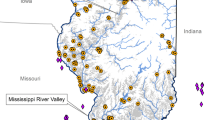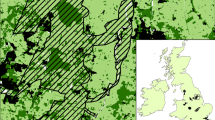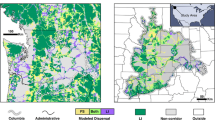Abstract
Context
The current biodiversity crisis has intensified the need to predict species responses to landscape modification and has renewed attention on the fundamental question of what influences the dynamics of species distributions. Landscape composition can affect two main components that dictate distributions: habitat suitability and habitat connectivity. Elucidating the relative importance of these factors and associated landscape features can help prioritize management action for species conservation.
Objectives
Our objective was to use species distribution models and network-based landscape connectivity models to understand which landscape factors were most predictive of the distribution of an anuran, Blanchard’s cricket frog (Acris blanchardi), in an agriculturally-dominated landscape.
Methods
We conducted our study in Ohio, USA, near the edge of the cricket frog’s contracting range. To obtain a current assessment of cricket frog distribution, we surveyed 367 pond and stream locations across three North–South transects. We then tested seven regression models, combining habitat suitability and landscape connectivity metrics, to determine which factors best predicted cricket frog presence.
Results
We detected cricket frogs in 24% of surveyed locations and they were more likely to occupy pond sites than stream sites. Cricket frog presence was best predicted by models with habitat suitability and the number of interconnected habitat patches. We found that, while there was high variation in habitat suitability across the study area, landscape connectivity was relatively uniform where we surveyed.
Conclusions
Agricultural landscapes around the world are often mosaics of land cover types, which may functionally provide connectivity for some species. In such areas, conservation management should focus on preserving and restoring regions of highly suitable habitat. This focus may be particularly relevant for species that do not appear to be dispersal limited and, therefore, able to maintain metapopulation dynamics.



Similar content being viewed by others
Availability of data and materials
Upon publication, requests can be made to the corresponding Author for data.
Code availability
Upon publication, requests can be made to the corresponding author for code.
References
Albert CH, Rayfield B, Dumitru M, Gonzalez A (2017) Applying network theory to prioritize multispecies habitat networks that are robust to climate and land-use change. Conserv Biol 31:1383–1396
Allen C, Gonzales R, Parrott L (2020) Modelling the contribution of ephemeral wetlands to landscape connectivity. Ecol Model 419:108944
Baguette M, Dyck H (2007) Landscape connectivity and animal behavior: functional grain as a key determinant for dispersal. Landsc Ecol 22:1117–1129
Bahn V, O’Connor RJ, Krohn WB (2006) Effect of dispersal at range edges on the structure of species ranges. Oikos 115:89–96
Băncilă RI, Cogălniceanu D, Ozgul A, Schmidt BR (2017) The effect of aquatic and terrestrial habitat characteristics on occurrence and breeding probability in a montane amphibian: insights from a spatially explicit multistate occupancy model. Popul Ecol 59:71–78
Bateman BL, Murphy HT, Reside AE, Mokany K, VanDerWal J (2013) Appropriateness of full-, partial- and no-dispersal scenarios in climate change impact modelling. Divers Distrib 19:1224–1234
Boone MD, Davis AY, Dumyahn S, Freund A, Mendoza R, Muniz-Torres A (Unpublished data) Use of exurban lands by pond-breeding amphibians in agricultural areas: factors that predict patch occupation in human-dominated habitats
Brooks GC, Smith JA, Frimpong EA, Gorman TA, Chandler HC, Haas CA (2019) Indirect connectivity estimates of amphibian breeding wetlands from spatially explicit occupancy models. Aquat Conserv Mar Freshw Ecosyst 29:1815–1825
Brown JL (2014) SDMtoolbox: a python-based GIS toolkit for landscape genetic, biogeographic, and species distribution model analyses. Methods Ecol Evol 5:694–700
Brown JH, Kodric-Brown A (1977) Turnover rates in insular biogeography: effect of immigration on extinction. Ecology 58:445–449
Brown JH, Stevens GC, Kaufman DM (1996) The geographic range: size, shape, boundaries, and internal structure. Annu Rev Ecol Syst 27:597–623
Bull EL (2009) Dispersal of newly metamorphosed and juvenile western toads (Anaxyrus boreas) in northeastern Oregon, USA. Herpetol Conserv Bio 4:236–247
Channell R, Lomolino MV (2000) Dynamic biogeography and conservation of endangered species. Nature 403:84–86
Clauzel C, Fotete J, Girardet X, Vuidel G (2016) Graphab 2.0 User Manual. 2016-05-12
Cord A (2011) Inclusion of habitat availability in species distribution models through multi-temporal remote sensing data? Ecol Appl 21:3285–3298
Elith J, Leathwick JR (2009) Species distribution models: ecological explanation and prediction across space and time. Annu Rev Ecol Evol Syst 40:677–697
Elith J, Phillips SJ, Hastie T, Dudik M, Chee YE, Yates CJ (2011) A statistical explanation of MaxEnt for ecologists. Divers Distrib 17:43–57
Evangelista PH, Kumar S, Stohlgren TJ, Jarnevich CS, Crall AW, Norman JB, Barnett DT (2008) Modelling invasion for a habitat generalist and specialist plant species. Divers Distrib 14:808–817
Fahrig L (2003) Effects of habitat fragmentation on biodiversity. Annu Rev Ecol Evol Syst 34:487–515
Fiske I, Chandler R (2011) unmarked: an R package for fitting hierarchical models of wildlife occurrence and abundance. J Stat Softw 43:1–23
Foltête JC, Clauzel C, Vuidel G (2012a) A software tool dedicated to the modelling of landscape networks. Environ Model Softw 38:316–327
Foltête JC, Clauzel C, Vuidel G, Tournant P (2012b) Integrating graph-based connectivity metrics into species distribution models. Landsc Ecol 27:557–569
Gonzalez-Salazar C, Stephens CR, Marquet PA (2013) Comparing the relative contributions of biotic and abiotic factors as mediators of species’ distributions. Ecol Model 248:57–70
Gould WR, Patla DA, Daley R, Corn PS, Hossack BR, Bennetts RE, Peterson CR (2012) Estimating occupancy in large landscapes: evaluation of amphibian monitoring in the greater Yellowstone ecosystem. Wetlands 32:379–389
Gray RH, Brown LE, Blackburn L (2005) Decline of northern cricket frogs (Acris crepitans). In: Lannoo MJ (ed) Amphibian declines: the status of United States species. University of California Press, Berkeley, pp 441–443
Guisan A, Thuiller W (2005) Predicting species distribution: offering more than simple habitat models. Ecol Lett 8:993–1009
Haddad NM, Brudvig LA, Clobert J et al (2015) Habitat fragmentation and its lasting impact on Earth’s ecosystems. Sci Adv 1:1–10
Hartel T, Nemes S, Öllerer K, Cogalniceanu D, Moga C, Arntzen JW (2010) Using connectivity metrics and niche modelling to explore the occurrence of the northern crested newt Triturus cristatus (Amphibia, Caudata) in a traditionally managed landscape. Environ Conserv 37:195–200
Hein CL, Öhlund G, Englund G (2011) Dispersal through stream networks: modelling climate-driven range expansions of fishes. Divers Distrib 17:641–651
Hernandez PA, Graham CH, Master LL, Albert DL (2006) The effect of sample size and species characteristics on performance of different species distribution modeling methods. Ecography 29:773–785
Holt RD, Keitt TH, Lewis MA, Maurer BA, Taper ML (2005) Theoretical models of species’ borders: single species approaches. Oikos 108:18–27
Holtmann L, Philipp K, Becke C, Fartmann T (2017) Effects of habitat and landscape quality on amphibian assemblages of urban stormwater ponds. Urban Ecosyst 20:1249–1259
Homer CG, Dewitz JA, Yang L, Jin S, Danielson P, Xian GZ, Coulston J, Herold N, Wickham J, Megown K (2015) Completion of the 2011 National Land Cover Database for the conterminous United States—representing a decade of land cover change information. Photogramm Eng Remote Sens 81(5):345–354
Hosmer DW, Lemeshow S (2000) Chapter 5—applied logistic regression, 2nd edn. Wiley, New York, NY, pp 160–164
Jeliazkov A, Lorrillière R, Besnard A, Garnier J, Silvestre M, Chiron F (2019) Cross-scale effects of structural and functional connectivity in pond networks on amphibian distribution in agricultural landscapes. Freshw Biol 64:997–1014
Joly P (2019) Behavior in a changing landscape: using movement ecology to inform the conservation of pond-breeding amphibians. Front Ecol Evol 7:1–17
Keyghobadi N (2007) The genetic implications of habitat fragmentation for animals. Can J Zool 85:1049–1064
Lehtinen RM, Skinner AA (2006) The enigmatic decline of Blachard’s cricket frog (Acris crepitans blanchardi): a test of the habitat acidification hypothesis. Copeia 2006:159–167
Lehtinen RM, Witter JA (2014) Detecting frogs and detecting declines: an examination of occupancy and turnover patterns at the range edge of Blanchard’s Cricket Frog (Acris blanchardi). Herpetol Conserv Bio 9:502–515
Levins R (1969) Some demographic and genetic consequences of environmental heterogeneity for biological control. Bull Entomol Soc Am 15:237–240
MacKenzie DI, Nichols JD, Lachman GB, Droege S, Royle JA, Langtimm CA (2002) Estimating site occupancy rates when detection probabilities are less than one. Ecology 83:2248–2255
Matos C, Petrovan SO, Wheeler PM, Ward AI (2019) Landscape connectivity and spatial prioritization in an urbanizing world: a network analysis approach for a threatened amphibian. Biol Conserv 237:238–247
Mazerolle MJ (2019) AICcmodavg: model selection and multimodel inference based on (Q)AIC(c). R package version 2.2-1
McCallum ML (2010) Future climate change spells catastrophe for Blanchard’s cricket frog, Acris blanchardi (Amphibia:Anura:Hylidae). Acta Herpetol 5:119–130
NOAA (2021) 1991–2020 US Climate Normals for Lima OH. National Centers for Environmental Information. National Oceanic and Atmospheric Administration. https://www.ncei.noaa.gov/access/us-climate-normals/
Ofori BY, Stow AJ, Baumgartner JB, Beaumont LJ (2017) Combining dispersal, landscape connectivity and habitat suitability to assess climate-induced changes in the distribution of Cunningham’s skink, Egernia cunninghami. PLoS ONE 12:e0184193
OGRIP. Ohio geographically referenced information program: digital elevation model. Data downloaded from https://ogrip.oit.ohio.gov/ServicesData/GEOhioSpatialInformationPortal/USGSGeodataDistribution(Historical)/DEM.aspx. Accessed 26 Feb 2021
Ohio Frog and Toad Calling Survey. Data provided by Jeff Davis. http://Ohioamphibians.com. Accessed 26 Feb 2021
Pascual-Hortal L, Saura S (2006) Comparison and development of new graph-based landscape connectivity indices: towards the prioritization of habitat patches and corridors for conservation. Landsc Ecol 21:959–967
Pearson RG, Dawson TP (2015) Predicting the impacts of climate change on the distribution of species: are bioclimate envelope models useful? Glob Ecol Biogeogr 12:361–371
Pfingsten RA, Davis JG, Matson TO, Lipps G, Wynn D, Armitage BJ (2013) Amphibians of Ohio. Ohio Biological Survey. 900 pp
Phillips SJ, Anderson RP, Schapire RE (2006) Maximum entropy modeling of species geographic distributions. Ecol Model 190:231–259
Poff NL (1997) Landscape filters and species traits: towards mechanistic understanding and prediction in stream ecology. J N Am Benthol Soc 16:391–409
Poniatowski D, Stuhldreher G, Loffler F, Fartmann T (2018) Patch occupancy of grassland specialists: habitat quality matters more than habitat connectivity. Biol Conserv 225:237–244
Puglis HJ, Boone MD (2012) Effects of terrestrial buffer zones on amphibians on golf courses. PLoS ONE 7:e39590
Pulliam HR (2000) On the relationship between niche and distribution. Ecol Lett 3:349–361
R Core (2017) R: a language and environment for statistical computing. R Foundation for Statistical Computing, Vienna, Austria. https://www.R-project.org/
Rayfield B, Fortin M-J, Fall A (2011) Connectivity for conservation: a framework to classify network measures. Ecology 92:847–858
Ribeiro R, Carretero MA, Sillero N, Alarcos G, Ortiz-Santaliestra M, Lizana M, Llorente GA (2011) The pond network: can structural connectivity reflect on (amphibian) biodiversity patterns? Landsc Ecol 26:673–682
Rudnick DS, Ryan SJ, Beier P, Cushman SA, Dieffenbach F, Epps CW, Gerber LR, Hartter J, Jenness JS, Kintsch J, Merenlender AM, Perkl RM, Reziosi DV, Trombulak SC (2012) The roll of landscape connectivity in planning and implementing conservation and restoration priorities. Issues Ecol 16:1–20
Scheele BC, Driscoll DA, Fischer J, Fletcher AW, Hanspach J, Voros J, Hartel T (2015) Landscape context influences chytrid fungus distribution in an endangered European amphibian. Anim Conserv 18:480–488
Scherer RD, Muths E, Noon BR (2012) The importance of local and landscape-scale processes to the occupancy of wetlands by pond-breeding amphibians. Popul Ecol 54:487–498
Schivo F, Mateo-Sanchez MC, Bauni V, Quintana RD (2020) Influence of land-use/land-cover change on landscape connectivity for an endemic threatened amphibian (Argenteohyla siemersi pederseni, Anura: Hylidae). Landsc Ecol 35:1481–1494
Sexton JP, McIntyre PJ, Angert AL, Rice KJ (2009) Evolution and ecology of species range limits. Annu Rev Ecol Evol Syst 40:415–436
Smith MA, Green DM (2005) Dispersal and the metapopulation paradigm in amphibian ecology and conservation: are all amphibian populations metapopulations? Ecography 28:110–128
Svenning J-C, Normand S, Skov F (2008) Postglacial dispersal limitation of widespread forest plant species in nemoral Europe. Ecography 31:316–326
Treasure AM, Chown SL (2013) Contingent absences account for range limits but not the local abundance structure of an invasive springtail. Ecography 36:146–156
Trumbo DR, Burgett AA, Hopkins RL, Biro EG, Chase JM, Knouft JH (2012) Integrating local breeding pond, landcover, and climate factors in predicting amphibian distributions. Landsc Ecol 27:1183–1196
Urban D, Keitt T (2001) Landscape connectivity: a graph-theoretic perspective. Ecology 82:1205–1218
USGS NHD 2014: United States Geological Survey: National hydrography dataset—Best resolution. Downloaded from The National Map. https://apps.nationalmap.gov/viewer. Accessed 26 Feb 2021
USGS NTD 2014: United States Geological Survey: National Transportation Dataset. Downloaded from The National Map. https://apps.nationalmap.gov/viewer/. Accessed 26 Feb 2021
Weir LA, Mossman MJ (2005) North American amphibian monitoring program (NAAMP). In: Lannoo M (ed) Amphibian declines: conservation status of United States amphibians. University of California Press, Berkeley, CA, pp 307–313
Wetsch O, Strasburg M, McQuigg J, Boone MD (Unplublished data) Is overwintering mortality driving enigmatic declines? Evaluating the impacts of multiple parasites on an anuran across life stages
WorldClim. Bioclimatic variables. https://worldclim.org/. Data downloaded 4/2014. Accessed 25 Feb 2021
Wright AD, Grant EHC, Zipkin EF (2020) A hierarchical analysis of habitat area, connectivity, and quality on amphibian diversity across spatial scales. Landsc Ecol 35:529–544
Youngquist MB, Boone MD (2014) Movement of amphibians through agricultural landscapes: the role of habitat on edge permeability. Biol Conserv 175:148–155
Youngquist MB, Inoue K, Berg DJ, Boone MD (2017) Effects of land use on population presence and genetic structure of an amphibian in an agricultural landscape. Landsc Ecol 32:147–162
Zamberletti P, Zaffaroni M, Accatino F, Creed IF, Michele CD (2018) Connectivity among wetlands matters for vulnerable amphibian populations in wetlandscapes. Ecol Model 384:119–127
Acknowledgements
This project was funded by National Science Foundation Doctoral Dissertation Improvement Grant (DDIG) to MBY. We thank Dr. R. Lehtinen and J. Davis for providing data of cricket frog presence across Ohio; T. Drought and K. Inoue for assisting with surveys; M. Strasburg, J. McQuigg, M. Murphy, C. Dvorsky, and O. Wetsch for reading earlier versions of this paper; and S. Rumschlag and T. Hoskins for general support.
Funding
Funding for this project was provided by the National Science Foundation Doctoral Dissertation Improvement Grant (DDIG) to MBY. Award Number: 1406814.
Author information
Authors and Affiliations
Contributions
MBY designed the study, conducted the investigation, analyzed the data, and wrote the manuscript, and was awarded funding as co-PI. MDB assisted in study design and advised MBY on all aspects of the study, provided editorial advice, and was awarded funding as PI.
Corresponding author
Ethics declarations
Conflict of interest
Not applicable.
Ethical approval
Methods were approved by Miami University Institutional Animal Care and Use Committee. IACUC Project Number: 914.
Consent for publication
All authors consent for publication.
Additional information
Publisher's Note
Springer Nature remains neutral with regard to jurisdictional claims in published maps and institutional affiliations.
Supplementary Information
Below is the link to the electronic supplementary material.
Rights and permissions
About this article
Cite this article
Youngquist, M.B., Boone, M.D. Making the connection: combining habitat suitability and landscape connectivity to understand species distribution in an agricultural landscape. Landscape Ecol 36, 2795–2809 (2021). https://doi.org/10.1007/s10980-021-01295-7
Received:
Accepted:
Published:
Issue Date:
DOI: https://doi.org/10.1007/s10980-021-01295-7




